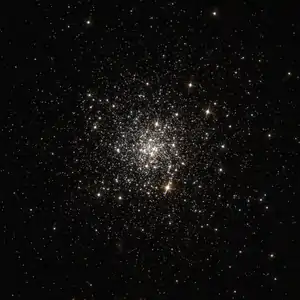NGC 4147
NGC 4147 is the New General Catalogue identifier for a globular cluster of stars in the northern constellation of Coma Berenices. It was discovered by English astronomer William Herschel on March 14, 1784, who described it as "very bright, pretty large, gradually brighter in the middle".[7] With an apparent visual magnitude of 10.7,[4] it is located around 60,000[3] light years away from the Sun at a relatively high galactic latitude of 77.2°.[6]
| NGC 4147 | |
|---|---|
 | |
| Observation data (J2000 epoch) | |
| Class | IX[1] |
| Constellation | Coma Berenices |
| Right ascension | 12h 10m 06.149s[2] |
| Declination | +18° 32′ 31.78″[2] |
| Distance | 60 kly (19 kpc)[3] |
| Apparent magnitude (V) | 10.74[4] |
| Apparent dimensions (V) | 1.730′ × 1.592′[2] |
| Physical characteristics | |
| Mass | 37,200[5] M☉ |
| Tidal radius | 6.6′[6] |
| Metallicity | = −1.78[4] dex |
| Estimated age | ~14 Gyr[7] |
This is a relatively small globular cluster, ranking 112th in luminosity among the Milky Way globular cluster population. It is considered an Oosterhoff type I cluster (OoI), despite having a relatively low metallicity. Indeed, it has the lowest metallicity of any OoI cluster known. There are 19 RR Lyrae variable star candidates and as many as 23 blue stragglers. A high proportion of the latter are concentrated near the dense core of the cluster, which is consistent with the idea that blue stragglers form through stellar mergers.[3][8]
The cluster lies some 70.4 ± 7.5 kly (21.6 ± 2.3 kpc) from the Galactic Center,[6] and is relatively isolated from other globular clusters in the galaxy.[3] The position of this cluster makes it a candidate for association with the Sagittarius tidal stream, and thus it may have been captured by the Milky Way after separation from the Sagittarius Dwarf Spheroidal Galaxy.[6] A contour map of the cluster appears to show S-shaped tidal arms stretching to the north and south for several tidal radii. Such features are predicted for globular clusters that follow elliptical orbits and are near their apogalacticon.[9]
References
- Shapley, Harlow; Sawyer, Helen B. (August 1927), "A Classification of Globular Clusters", Harvard College Observatory Bulletin, 849 (849): 11–14, Bibcode:1927BHarO.849...11S.
- Skrutskie, M. F.; et al. (February 2006), "The Two Micron All Sky Survey (2MASS)", Astrophysical Journal, 131 (2): 1163–1183, Bibcode:2006AJ....131.1163S, doi:10.1086/498708.
- Stetson, Peter B.; et al. (December 2005), "Homogeneous Photometry. V. The Globular Cluster NGC 4147", The Publications of the Astronomical Society of the Pacific, 117 (838): 1325–1361, arXiv:astro-ph/0508650, Bibcode:2005PASP..117.1325S, doi:10.1086/497302.
- Dalessandro, Emanuele; et al. (November 2012), "Ultraviolet Properties of Galactic Globular Clusters with Galex. II. Integrated Colors", The Astronomical Journal, 144 (5): 13, arXiv:1208.5698, Bibcode:2012AJ....144..126D, doi:10.1088/0004-6256/144/5/126, 126.
- Kimmig, Brian; et al. (February 2015), "Measuring Consistent Masses for 25 Milky Way Globular Clusters", The Astronomical Journal, 149 (2): 15, arXiv:1411.1763, Bibcode:2015AJ....149...53K, doi:10.1088/0004-6256/149/2/53, 53.
- Carballo-Bello, Julio A.; et al. (December 2014), "A search for stellar tidal debris of defunct dwarf galaxies around globular clusters in the inner Galactic halo", Monthly Notices of the Royal Astronomical Society, 445 (3): 2971–2993, arXiv:1409.7390, Bibcode:2014MNRAS.445.2971C, doi:10.1093/mnras/stu1949.
- O'Meara, Stephen James (2011), Deep-Sky Companions: The Secret Deep, 4, Cambridge University Press, pp. 225–228, ISBN 978-1139500074.
- Arellano Ferro, A.; et al. (October 2004), "CCD Photometry of the RR Lyrae Stars in NGC4147", Revista Mexicana de Astronomía y Astrofísica, 40: 209–221 (2004), Bibcode:2004RMxAA..40..209A.
- Jordi, K.; Grebel, E. K. (November 2010), "Search for extratidal features around 17 globular clusters in the Sloan Digital Sky Survey", Astronomy and Astrophysics, 522: 23, arXiv:1008.2966, Bibcode:2010A&A...522A..71J, doi:10.1051/0004-6361/201014392, A71.
